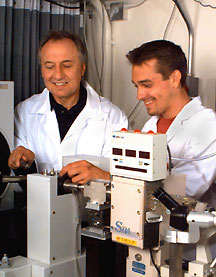Life After the Human Genome Project: TSRI Researchers Spearhead
Protein Structure Initiative
By Mika Ono
The human genome has been sequenced. Now what? According
to The Scripps Research Institute (TSRI) Molecular Biology
Professor Ian Wilson, one of the next steps is to focus on
the proteins the genes code for—to find what these proteins
look like and what they do.
“Right now there is no way to look at most amino acid
sequences [determined by a gene] and tell what the protein
looks like,” comments Wilson. "To be able to do this
would represent an important advance in our understanding."
The National Institutes of Health (NIH) seems to agree.
Under the auspices of The National Institute of General Medical
Sciences, the NIH recently launched a nationwide initiative
on protein structure determination, with an emphasis on developing
high-throughput technology that could one day support efforts
to find and catalog the structures of all proteins active
in the human body. In 2000, the NIH awarded roughly $30 million
for the first year to seven centers—one of which is headed
by Wilson.
One of the first tasks of the centers will be to organize
all known proteins into structural ("fold") families based
on their genetic sequences. The centers will then determine
the structure of one or more proteins from each family. The
stated goal of the NIH is to determine 10,000 new protein
structures in 10 years, forming the backbone of a public resource
linking information on sequence, structure, and function.
A New Way of Doing Science
According to Wilson, the NIH Protein Structure Initiative
is a dramatic departure from science as usual.
"The ambitious goals of the project have led us into new
territory," he says. "To my knowledge, this is the first time
the NIH has funded technology centers instead of hypothesis-driven
research, like RO1s. But the logic goes that over the long
term, the new high-throughput technologies will help drive
discoveries."
The large scope of the project also has implications for
the way research is organized. "This kind of project encourages
multi-institutional collaborations," Wilson comments. "This
is a different way of doing science—and a different way
of competing—but one I believe we'll be seeing increasingly
in the future."
Wilson's group, dubbed the Joint Center for Structural Genomics,
draws on talent from several top-notch California institutions,
both public and private. The main players are: TSRI, The Genomics
Institute of the Novartis Research Foundation (GNF), University
of California at San Diego (UCSD), and the Stanford Synchrontron
Radiation Laboratory (SSRL, a Division of the Stanford Linear
Accelerator Center, SLAC) at Stanford University.
More than 60 researchers are involved in the consortium,
which also includes collaborators from around the world and
from other local institutions, such as The Salk Institute.
Other TSRI scientists affiliated with the project include:
Ruben Abagyan, Geoffrey Chang, Jack Johnson, Peter Schultz,
and Ray Stevens.
The group will receive $24 million over five years (funds
that are in addition to, not instead of, those supporting
more traditional NIH projects).
"Spread among multiple institutions over five years, the
amount isn't as significant as it first seems," comments Wilson.
"But we're still in the pilot stage of the NIH initiative.
To me, the important thing is to be involved from the beginning."
1 | 2 |

|

Professor Ian Wilson (left), shown here
working with graduate student Dennis Wolan, heads a consortium
of researchers developing high-throughput technology to find
and catalog protein structures.
|

